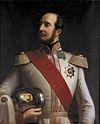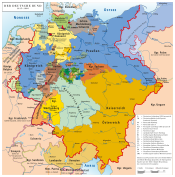Kingdom of Hanover
Kingdom of Hanover Königreich Hannover (German) | |||||||||||
|---|---|---|---|---|---|---|---|---|---|---|---|
| 1814–1866 | |||||||||||
| Motto: Suscipere et Finire "Support and Finish" | |||||||||||
| Anthem: Heil dir, Hannover "Hail to you, Hanover" | |||||||||||
Roman Catholicism | |||||||||||
| Government | Constitutional monarchy | ||||||||||
| King | |||||||||||
• 1814–1820 | George III | ||||||||||
• 1820–1830 | George IV | ||||||||||
• 1830–1837 | William IV | ||||||||||
• 1837–1851 | Ernest Augustus | ||||||||||
• 1851–1866 | George V | ||||||||||
| Legislature | German revolutions | 13 March 1848 | |||||||||
| 14 June 1866 | |||||||||||
| 23 August 1866 | |||||||||||
• Annexed by Prussia | 20 September 1866 | ||||||||||
| Currency | Hanoverian thaler (1814–1857) Hanoverian vereinsthaler (1857–1866) | ||||||||||
| |||||||||||
| Today part of | Germany Netherlands[dubious ] | ||||||||||

The Kingdom of Hanover (German: Königreich Hannover) was established in October 1814 by the Congress of Vienna, with the restoration of George III to his Hanoverian territories after the Napoleonic era. It succeeded the former Electorate of Hanover,[2] and joined 38 other sovereign states in the German Confederation in June 1815. The kingdom was ruled by the House of Hanover, a cadet branch of the House of Welf, in personal union with Great Britain between 1714 and 1837. Since its monarch resided in London, a viceroy, usually a younger member of the British royal family, handled the administration of the Kingdom of Hanover.
The personal union with the United Kingdom ended in 1837 upon the accession of
History
The territory of Hanover had earlier been a principality within the Holy Roman Empire before being elevated into an electorate in 1708, when Hanover was formed by union of the dynastic divisions of the Duchy of Brunswick-Lüneburg, excepting the Principality of Brunswick-Wolfenbüttel.
After his accession in 1714, George Louis of the House of Hanover ascended the throne of Great Britain as
The terms of the Congress of Vienna in 1814 not only restored Hanover but also elevated it to an independent kingdom with its Prince-Elector, George III of the United Kingdom, as King of Hanover. The new kingdom was also greatly expanded and became the fourth-largest state in the German Confederation (behind Prussia, Austria and Bavaria) and the second-largest in northern Germany.
George III never visited the kingdom during his 60-year reign. Having succumbed to
Ernest Augustus, now the eldest surviving son of George III, succeeded to the throne as King of Hanover. Adolph Frederick, the younger brother and long-time Viceroy, returned to Britain. Ernest Augustus had a personally-strained relationship with his niece Queen Victoria, and they frequently squabbled over family affairs. Domestically, his reign began with a constitutional crisis as he tried to suspend parliament and nullify the written constitution of 1819. He also presided over the country during the turbulent Revolutions of 1848.
His son, George V, assumed the throne in 1851. During the Austro-Prussian War (1866), Hanover attempted to maintain a neutral position, along with some other member states of the German Confederation. Hanover's vote in favor of the mobilisation of Confederation troops against Prussia on 14 June 1866 prompted Prussia to declare war. The outcome of the war led to the dissolution of Hanover as an independent kingdom, which was annexed by the Kingdom of Prussia and became the Prussian Province of Hanover. Along with the rest of Prussia, it became part of the German Empire in 1871.
After George V fled Hanover in 1866, he raised forces loyal to him in the
The
Revival and modern history

With Prussia on the verge of official dissolution (1947), Hanoverian politicians in 1946 took advantage of the opportunity and advocated that the
Reorganisation of religious bodies
The
In 1848, the Lutheran parishes were democratised by the introduction of
After the Prussian conquest in 1866, on 19 September 1866, the day before the official Prussian annexation took place and with the last summus episcopus, King George V of Hanover, in exile, the Kingdom's six consistories joined to form today's still-existing church body, the Lutheran State Church of Hanover. An all-Hanoverian consistory, the Landeskonsistorium (state consistory), was formed with representatives from the regional consistories.
While the
In 1842, Hanover finally granted equal rights to Jews and promoted to build up Jewish congregations, where this did not already happen earlier, and a superstructure of four regional land-rabbinates. These were the Emden Land-Rabbinate (Aurich and Osnabrück regions), the Hanover Land-Rabbinate (Hanover and Lüneburg regions), the Hildesheim Land-Rabbinate (Hildesheim region and Clausthal Mountain Captaincy), and the Stade Land-Rabbinate (Stade region).[6]
In many diaspora areas Jews regarded this a progress and a burden alike, because of the implied financial burden for
Kings
In 1813, George III was restored to his Hanoverian territories, and in October 1814, they were constituted as the independent Kingdom of Hanover at the Congress of Vienna. The
| Portrait | Name | Lifespan | Reign began | Reign ended | Succession | Notes |
|---|---|---|---|---|---|---|

|
George III : Georg III.
German |
4 June 1738 – 29 January 1820 (aged 81) |
12 October 1814 | 29 January 1820 | Previously Prince Elector of Hanover from 1760 to 1806. | George III was mentally incapacitated during these years, and his constitutional powers were exercised by his eldest son, George Augustus Frederick (the future George IV), as Regent. In Hanover, his youngest son, Prince Adolphus, Duke of Cambridge, officiated as Viceroy from 1816. |

|
George IV German: Georg IV. |
12 August 1762 – 26 June 1830 (aged 67) |
29 January 1820 | 26 June 1830 | Son of George III. | Prince regent 1811–1820, represented in Hanover by his brother, the Duke of Cambridge, as Viceroy |

|
William IV German: Wilhelm IV. |
21 August 1765 – 20 June 1837 (aged 71) |
26 June 1830 | 20 June 1837 | Son of George III • Younger brother of George IV. | Last monarch to rule both Hanover and the United Kingdom, represented in Hanover by his brother, the Duke of Cambridge, as Viceroy |

|
Ernest Augustus German: Ernst August. |
5 June 1771 – 18 November 1851 (aged 80) |
20 June 1837 | 18 November 1851 | Son of George III • Younger brother of George IV and William IV. | The accession of Queen Victoria separated the crowns of the United Kingdom and Hanover, and the latter passed to her uncle. |

|
George V German: Georg V. |
27 May 1819 – 12 June 1878 (aged 59) |
18 November 1851 | 20 September 1866 | Son of Ernest Augustus. | Hanover was annexed by Prussia in the aftermath of the Austro-Prussian War. |
Territory and administrative subdivisions

The Congress of Vienna instituted a territorial adjustment between Hanover and Prussia to form more contiguous borders. Hanover increased its area substantially, gaining the
Hanover thus comprised a number of territories, which had been Imperial Estates within the Holy Roman Empire. Their respective governments, now called provincial governments, were organised according to partially very old traditions, including different levels of estate participation in rule. In 1823, the kingdom was reorganised into high-bailiwicks (German: Landdrosteien, singular: Landdrostei), each led by a high-bailiff (German: Landdrost) according to unitary standards, thus doing away with the inherited provincial peculiarities.
The high-bailiwicks were subdivided into bailiwicks (
- Aurich, comprising former East Frisia
- Hanover, comprising about the former Principality of Calenberg in the Duchy of Brunswick-Lüneburg
- Hildesheim, comprising the former Brunswick-Lüneburg Principality of Grubenhagen and the former Prince-Bishopric of Hildesheim
- Lüneburg, comprising the former Brunswick-Lüneburg Principality of Lüneburg and the remainder of Saxe-Lauenburg areas
- Osnabrück, comprising the former County of Bentheim, the former Lower County of Lingen, and the former Prince-Bishopric of Osnabrück
- Stade, comprising the former Duchies of Bremen-Verden
The Hanoverian subdivisions into high-bailiwicks and bailiwicks remained unchanged until 1 April 1885, when they were replaced by Prussian-style provinces (Regierungsbezirke) and districts (Kreise).
Image gallery
-
The Leine Palace
-
HerrenhausenCastle and Gardens
-
Marienburg Castle, present seat of the Princes of Hanover
Army
The Kingdom of Hanover maintained an army after the Napoleonic Wars. In 1832, King William IV of Hanover and the United Kingdom issued his troops with British Army uniforms, but they differed slightly from their original British versions. When the personal union with the United Kingdom ended in 1837 and Ernst August ascended to the crown of Hanover, he replaced their uniforms with Prussian Army-style ones, which included the pickelhaube spiked helmet for his Guard Corps. By 1866 they wore a more Austrian style of uniform, with only the guard corps keeping the Prussian one. During the Austro-Prussian War, the Hanoverian Army fought and defeated the Prussians during its march south towards Austria, at the Battle of Langensalza. However, it was later surrounded and forced to surrender to Prussia.[9]
Standard, ensign and coat of arms
After the personal union with the United Kingdom ended in 1837 with the accession of Queen Victoria, Hanover kept the
-
Royal standard of Hanover, 1816–1837
-
Coat of arms of Hanover, 1837
See also
- Guelphic Legion
- King's German Legion
- Kleindeutsche Lösung
- State of Hanover
Notes
- ISBN 9780826266095.
The Evangelical Lutheran Church of Hanover, the official church of the kingdom
- ^ known formally as the Electorate of Brunswick-Lüneburg.
- ISBN 9780826266095.
The Evangelical Lutheran Church of Hanover, the official church of the kingdom
- Evangelical Reformed Church of the Province of Hanover emerged, comprising all the Calvinist congregations in the prevailingly Lutheran Province of Hanover. The simultaneously Lutheran and Calvinist consistory in Aurich was made the consistory of that church body, becoming an exclusively Calvinist body only in 1922, following the constitutional reorganisation of the church bodies after the Weimar Constitutionhad decreed the separation of church and state in 1919.
- ISBN 3-7605-8673-2. In the German original: "Es werden den Bekennern des jüdischen Glaubens die denselben "in" ["von", respectively] den einzelnen Bundesstaaten bereits eingeräumten Rechte erhalten."
- ISBN 3-931987-11-6.
- Weimar constitution— until the Nazi Reich's government de facto abolished the constitution in 1938.
- ^ This translation follows Jakob Heinrich Kaltschmidt, Neues vollständiges Wörterbuch der englischen und deutschen Sprache nebst einem kurzen Abrisse der englischen und der deutschen Sprachlehre (English: A new and complete Dictionary of the English and German Languages with two Sketches of Grammar, 6th, rev. and enriched ed., Leipsic: Otto Holtze, 1890, p. 283. No ISBN
- ^ König, Lutz (1999). Kingdom of Hanover - German Civil War 1866. Retrieved 3 April 2017.
- ^ a b Colton, J. H. "National Flags". J. H. Colton. Retrieved 18 May 2014.
- ^ a b Johnson, Alvin Jewett. "Johnson's New Chart of National Emblems". Alvin Jewett Johnson. Retrieved 18 May 2014.










![Civil ensign of Hanover[10][11]](http://upload.wikimedia.org/wikipedia/commons/thumb/7/74/Civil_Ensign_of_Hannover_%281801-1866%29.svg/120px-Civil_Ensign_of_Hannover_%281801-1866%29.svg.png)
![Royal standard of Hanover after 1837[10][11]](http://upload.wikimedia.org/wikipedia/commons/thumb/3/3b/Flag_of_Hanover_%281692%29.svg/120px-Flag_of_Hanover_%281692%29.svg.png)
